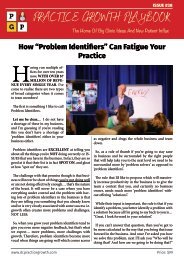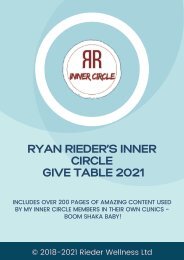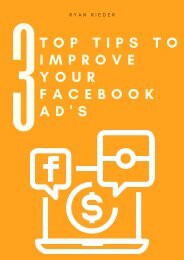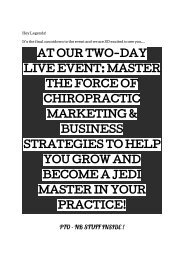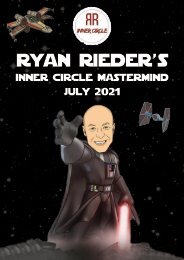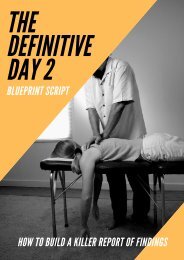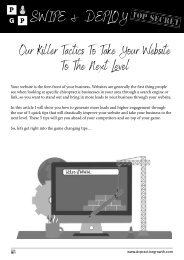9 Fundamentals to Grow Your Practice
Create successful ePaper yourself
Turn your PDF publications into a flip-book with our unique Google optimized e-Paper software.
RYAN RIEDER<br />
9<br />
FUNDAMENTALS<br />
TO GROW YOUR<br />
PRACTICE
9 WAYS TO GROW YOUR PRACTICE<br />
There are only nine ways for any practice <strong>to</strong> grow.<br />
People like <strong>to</strong> confuse the whole thing or complicate the whole thing but this is it.<br />
Here they are:<br />
1. Get more new patients<br />
2. See more people<br />
3. Raise prices<br />
4. Average adjustment fee<br />
5. Price positioning<br />
6. Care plans<br />
7. Increase PVA<br />
8. Conversions<br />
9. You<br />
#1: GET MORE NEW PATIENTS<br />
Number one is get more new patients. I've got a whole book on this, a whole course on it. It's not<br />
that hard.<br />
Any time I jump on calls with people, they're like, “I need more new patients.” And I'm like, “Okay,<br />
how many patients do you have?” We can always do with more new patients. I get it. But if you<br />
have five <strong>to</strong> 10 a week, that’s not what you should be focusing on now.<br />
10 new patients a week can give you the practice of your dreams.<br />
You need <strong>to</strong> do the basics. I'm really going <strong>to</strong> hit hard on this. If you're not sending two emails a<br />
week <strong>to</strong> your list, you're leaving a lot on the table I promise you. Two good solid emails a week <strong>to</strong><br />
your list. I know that makes many of you want <strong>to</strong> vomit in your mouth. But keep it conversational<br />
and send two emails a week <strong>to</strong> your list every single week.<br />
If you're not sending something in the post, you’re leaving something on the table.<br />
So, do the basics.<br />
Go for new patients. There's only four real ways <strong>to</strong> do that:<br />
• Screenings: I promise you it's the most fundamental best basis of marketing in the industry.<br />
I really truly believe that from the bot<strong>to</strong>m of my heart. Screenings is a legitimate avenue<br />
for getting new patients.<br />
• Talks:<br />
• In-house Screenings:<br />
© 2018 - 2021 Rieder Wellness Ltd 1
• Facebook ads: You should be always doing that. When you open new practices, it's just<br />
about awareness. Just got there and just do those. There is definitely hyper-reactiveness in<br />
the marketplace these days for that type of stuff.<br />
Then holiday campaigns, back <strong>to</strong> school and then we're adding all the fillers, your print stuff and<br />
your welcome packs and follow up sequences and things like that.<br />
Do not economize on promotion and production.<br />
Again, I want <strong>to</strong> say that if you have between five and 10 new patients, or even anywhere close <strong>to</strong><br />
10 new patients, this is not the thing that I want you <strong>to</strong> be focusing heavily on. If you’re an<br />
associate based practice it never s<strong>to</strong>ps for you. There's never enough.<br />
#2: SEE MORE PEOPLE<br />
Number two, you’ve got <strong>to</strong> see more people, that's it. You don't have a choice – there are only three<br />
ways.<br />
1. Work more hours. Who wants <strong>to</strong> work more hours?<br />
2. See more people across<br />
3. See people for less<br />
That's it. There is no other way. If you're going <strong>to</strong> take that lever off the table, that's fine but then<br />
you’ve got <strong>to</strong> pull other levers way more aggressively.<br />
Those of you that are already seeing three or four across, this is probably one of the biggest lessons<br />
I ever learned from a good friend of mine and a true men<strong>to</strong>r and one of the greats of our<br />
profession. He probably doesn't get enough credit because he’s South African and says what he<br />
thinks. I’m talking about Dr. Fred Schofield.<br />
He says the number one reason people don't see volume is that don't have enough benches.<br />
I often have conversations with chiroprac<strong>to</strong>rs who say they want <strong>to</strong> see more people for less time.<br />
But the volume guys are going, “I want people in the practice for longer.”<br />
You might be with them for 30 seconds but if you've got eight benches, they're all lying down at<br />
once and you’re seeing eight <strong>to</strong> 10 across. Then they're in the practice for 10 <strong>to</strong> 15 minutes. But<br />
you can see a huge volume on two benches.<br />
For those of you who are open plan, I remember Wednesday mornings for me. I never had less than<br />
10 people waiting for an adjustment. If I ever looked up, I got intimidated. I started speaking fast<br />
and the patients could feel it.<br />
This is what we do wrong with open plan. When we're busy, we start speaking faster. The secret is<br />
you have <strong>to</strong> start speaking slow. The busier you are the slower you speak. You might be like a duck<br />
paddling away underneath, but you slow it right down.<br />
The way Fred saw thousands a week – on his busiest days, 500 in a day – they’d all walk in. They'd<br />
all block themselves and all are face down.<br />
If you are going across, you are not seeing one every five minutes. If you see 10 minute<br />
appointments, you're not seeing one every five minutes. You see two every 10, which is a different<br />
thing.<br />
It's slow and people are lying down, it's not rush, it's got panic. If Mary comes in and Mary's acute,<br />
Mary needs more time with you. Mary gets blocked. You say, “Mary, I need you <strong>to</strong> stay longer<br />
© 2018 - 2021 Rieder Wellness Ltd 2
<strong>to</strong>day.” I might adjust one segment, go on and do other things and Mary's in there for 30 minutes<br />
sometimes.<br />
Then I'm clearing and clearing, going back <strong>to</strong> Mary. John also needs a little bit more time, “John,<br />
you lie there. I need you <strong>to</strong> relax a little bit longer.”<br />
The hardest thing with open plan and multiple rooms is managing the energy. When someone's<br />
having a rough day, the whole room that he’s in has it <strong>to</strong>o. And you've got <strong>to</strong> be able <strong>to</strong> manage that<br />
energy.<br />
So, slow it down, especially when you're busy.<br />
If you’re not willing <strong>to</strong> see more people, then you take that lever off the table. If you do that, you<br />
leave me no choice, but <strong>to</strong> push you for price. But if you want growth, you've got <strong>to</strong> trust.<br />
#3: RAISE PRICES<br />
Number three is raise your prices.<br />
<strong>Your</strong> prices should all be fives and tens. Don't be 47 and don't be 43. There's no point. And if you're<br />
43, you're not allowed <strong>to</strong> raise your prices less than five – it must be seven or eight.<br />
Once you've raised your prices a bit and you’re in abundance, your next step is an obnoxious price<br />
rise, which is more than 10. You’ve got <strong>to</strong> go there and rip that.<br />
The only reason you're worried about a price rise is because you're fearful that people are going <strong>to</strong><br />
leave. That's a normal emotion.<br />
By the way, I'm part of some physiotherapy groups where they are charging $150 <strong>to</strong> $200 a session.<br />
Now, I'm going <strong>to</strong> ask you <strong>to</strong> charge that if you don’t want <strong>to</strong> try that, but you could be.<br />
So, the only reason you don't realize a price rise – and it’s the same for any human being, including<br />
me – is fear of loss. To take that off the table there's a couple of strategies.<br />
One is just do it for new patients and tell everyone who's currently under care that it doesn’t apply<br />
<strong>to</strong> them. They’ll appreciate that.<br />
Or you could raise your prices by 10 or 15 and tell everyone currently under care that you are<br />
raising their price by five. They'll appreciate that <strong>to</strong>o.<br />
Or you tell them you’re going <strong>to</strong> lock them in at the current prices for the rest of the year.<br />
“Everyone else is 55 but don't worry, you are just 45.” Either way, they're going <strong>to</strong> feel like rock<br />
stars.<br />
One thing I highly recommend is whenever you raise prices, please do not say the following<br />
sentence anywhere, “We regret <strong>to</strong> inform you…” We don’t regret it. It’s just, “Notice <strong>to</strong> all<br />
members. Our prices will be changing <strong>to</strong> (price) on (date).<br />
Then you add in capitals, “PLEASE ASK THE FRONT DESK HOW YOU CAN LOCK IN THE OLD PRICES.”<br />
Then either sell them care plans or move them across <strong>to</strong> membership <strong>to</strong> lock in their prices.<br />
You could sell a <strong>to</strong>n of care plans. Trust me, you would definitely do a record. That's why I say <strong>to</strong><br />
give it six weeks.<br />
It’s the only time you ever see your front desk sell, by the way. Because they save people money.<br />
They don't want <strong>to</strong> make you money but they wany <strong>to</strong> help patients save money!<br />
© 2018 - 2021 Rieder Wellness Ltd 3
When it comes <strong>to</strong> pricing in your business, one of the problems is that you're asking people at the<br />
front desk who potentially would never spend that type of money on the thing <strong>to</strong> sell it. I'm not<br />
saying definitely I'm saying potentially. You're asking them <strong>to</strong> have that conversation when they<br />
maybe can’t afford it.<br />
Remember, sympathy and empathy are two different things. If you are sympathetic in your initial<br />
consultations or report of findings, you will never sell.<br />
So, the front desk is sitting there and they are sympathetic because maybe they couldn't afford it.<br />
Empathy in a sale is a different thing but if you share the emotion, you cannot sell the thing.<br />
What I mean by that is if someone walks in<strong>to</strong> my business and they say, “Hey, Ryan, I can't afford it<br />
because my parents have been bankrupt, not once but twice. And, we lost all our cars and we lost<br />
our house,” I'm like, “Please don't pay the money.” Because I lived that emotion.<br />
I immediately go in<strong>to</strong> sympathy. But if you're empathetic, it's different.<br />
I'm telling you right now, that's a trigger for me. I'm working on it, but there's still stuff there.<br />
I’m sure if you’ve tried <strong>to</strong> raise prices, you’ve had resistance from your staff or team. This is where<br />
you have <strong>to</strong> be a leader. The leader sells the team on a better future, even when they're not sure<br />
themselves.<br />
You can never be a hundred percent sure, but then you work backwards <strong>to</strong> make sure that it is<br />
better because you've got skills.<br />
That's the greatest definition I've ever heard of a leader. A leader goes first. A leader has <strong>to</strong> sell<br />
everyone else on the better future that this decision is going <strong>to</strong> make for the collective. And they've<br />
got <strong>to</strong> look and feel and do all the certainty.<br />
Many very successful people say some obnoxious things like, “I am great at this and I'm going <strong>to</strong><br />
achieve this.” And most of the time, they're just trying <strong>to</strong> sell it <strong>to</strong> themselves, not everyone else.<br />
Then they can drag everyone along as a leader.<br />
So that's what’s needed. It’s, “Trust me on this. We're raising prices.”<br />
#4: AVERAGE ADJUSTMENT FEE<br />
Number four is average adjustment fee, which is different from raising prices. There are only two<br />
ways <strong>to</strong> clean that up.<br />
One, you have <strong>to</strong> know what it is. I've almost never met with any doc the first time where they are<br />
right about the average adjustment fee, where they spot on 100% know it for fact. Maybe there<br />
have been one or two, but almost everyone guesses and everyone rounds up.<br />
I’ll never forget one practice where they were £10 out in their estimate of the average adjustment<br />
fee.<br />
It <strong>to</strong>ok me 30 seconds. I was like, “Hang on, your turnover is this, your visits are this. It's impossible<br />
for your average adjustment fee <strong>to</strong> be that. How many weeks do you work? It's impossible. That's<br />
literally what I did.<br />
A lot of you need <strong>to</strong> look at that number squarely in the face and be frightened by it.<br />
So, the first way <strong>to</strong> clean that number up is <strong>to</strong> know it and the second is <strong>to</strong> know this stat.<br />
How many people did you see in the last 60 days below your line in the sand (which you're now<br />
going <strong>to</strong> draw)?<br />
© 2018 - 2021 Rieder Wellness Ltd 4
This is really in two parts. But the second part is probably going <strong>to</strong> be a bit complicated for most of<br />
you from a time perspective and you don't have <strong>to</strong> go <strong>to</strong> that depth.<br />
For associate practices, this is big for you. The associates need <strong>to</strong> see not only how many people<br />
they saw in the last 60 days or three months below the red line. They also need <strong>to</strong> know how much<br />
that costs them in three months. So, I show them that in monetary value.<br />
Our red line is 30% off, so I can show them they lost say $2000 in two months.<br />
For us, an acceptable discount is up <strong>to</strong> 30%. That's my red line in the sand, but you're going <strong>to</strong> have<br />
a red line in the sand.<br />
So, how many people did you see below your red line in the sand?<br />
Keep looking at it every week. You'll be horrified.<br />
Most of the open plan docs are the worst at this. That's going <strong>to</strong> be scary for them.<br />
It can be scary because you're seeing volume. So, “It's just one. Just another one. That's not a big<br />
deal. It's just another one, another one, another.”<br />
All of a sudden, it's 50 in the last 60 days and it all adds up.<br />
As I said <strong>to</strong> someone in one of my coaching calls, we're here for a good time, not for a long time.<br />
That means we can’t mess around for <strong>to</strong>o long, we have <strong>to</strong> sort this stuff out.<br />
#5: PRICE POSITIONING<br />
Number five is price positioning. This dovetails with numbers three and four but it’s a different<br />
point and it's worth mentioning.<br />
This is the positioning of the a la carte adjustment fee. Sometimes this is the only lever and it can<br />
be the reason you sell 20, 30, 40% more care plans.<br />
One of my docs did this recently and he was like, “Everyone's taking care plans. It's insane!”<br />
He pumped up his a la carte adjustment fee by so much that the care plans became a no brainer.<br />
Maybe you are charging $45 per adjustment but you actually want <strong>to</strong> sell care plans at $45 per<br />
adjustment. So, it's all about anchoring. You’re a la carte needs <strong>to</strong> be at $55.<br />
Not many people are going <strong>to</strong> pay that a la carte fee but it's a price positioning strategy as opposed<br />
<strong>to</strong> a price increase.<br />
The key <strong>to</strong> selling more care plans is you’ve got <strong>to</strong> s<strong>to</strong>p being so attached <strong>to</strong> it. I worked with a<br />
couple of docs that were close <strong>to</strong> retirement and they were just like, “Actually I don't want <strong>to</strong> see<br />
anyone. I’m hiking my prices.” They put their prices up by $50 and they saw more people.<br />
They wanted less but they ended up with more because they were not so attached <strong>to</strong> the outcome.<br />
So sometimes that is a lever that you can pull. I like having people on care plans and taking payper-visit<br />
off the table. That's essentially what you're doing.<br />
For single practice docs, that’s a nice strategy. For associate docs, it’s harder because almost no<br />
associate really sells care plans that well. They're okay at it, but they don't really like it because it<br />
doesn't immediately put cash in their bank.<br />
#6: CARE PLANS<br />
© 2018 - 2021 Rieder Wellness Ltd 5
Number six is care plans, which is a different strategy also. For some of you, that's your only lever<br />
you need is <strong>to</strong> have care plans where you either didn’t do a care plan before or you just change<br />
your care plans up.<br />
Remember, a confused mind doesn't buy. So, some of you just need <strong>to</strong> simplify. Maybe you've<br />
practiced for a few years and you've added this care plan, you've added this one and then you add<br />
another one on <strong>to</strong>p.<br />
Then, all of a sudden, you’ve got 15 care plans and you just need <strong>to</strong> simplify.<br />
You should follow the rule of three with any care plan. It's either three care plans <strong>to</strong> choose from or<br />
three different ways <strong>to</strong> pay. So, your plans might be 15, 35, 55 or 12, 24, 36. I normally say that<br />
your biggest one should not be double the middle one.<br />
If you want <strong>to</strong> sell more middle ones, then I want <strong>to</strong> take the big one off the table. So, I'm going <strong>to</strong><br />
go 12, 24 and then I'm going <strong>to</strong> go 42 because I want them <strong>to</strong> go, “I don't want the 42 but I don't<br />
want <strong>to</strong> look cheap and take the 12 one so I’ll take the 24.” You'll sell more middle numbers by<br />
potentially taking that off.<br />
Cash will always be king and it's a game changer for the conversation. If I ever adjusted full time<br />
again, I just would struggle doing it any other way because I just don't want <strong>to</strong> have the financial<br />
conversation every time. I want <strong>to</strong> have in once. Take it and leave it.<br />
#7: INCREASE PVA<br />
Let’s go <strong>to</strong> number seven, which is on the same lines, but a different strategy, it’s a different lever.<br />
Often, we talk about raising prices, average adjustment fee and price positioning in the same<br />
conversation. They are not the same conversation they do fall from the same remit. And then we<br />
often talk about care plans, PVA and conversions in the same conversation. They are not.<br />
So, number seven is increase PVA. Yes, if you sell care plans, you're going <strong>to</strong> increase your PVA but<br />
I'm going <strong>to</strong> give you the nuggets.<br />
Increasing your PVA is all about two concepts:<br />
• Anchoring<br />
• Future pacing<br />
It's about anchoring and future pacing and you can't anchor or future pace enough.<br />
For example, I might say <strong>to</strong> a group, “Those of you who have been with me for many years…” or<br />
“My long-term clients that have been with me for 15 years,” that's an anchor.<br />
There are other ways you anchor, for example testimonials. You purposely choose testimonials<br />
where they say things like “I've been coming <strong>to</strong> see Dr. Ryan for the last 15 years.”<br />
I was an associate in a practice where we had a Hall of Fame board. It was a bit messy but it<br />
definitely did the trick. We had a 50 club, a 100 club, a 200 club, a 300 club and those were all<br />
people with a number of adjustments. We had pho<strong>to</strong>s up on the boards.<br />
When you’re sitting there on your seventh visits and in front of you is a wall that that has a 50 club,<br />
a 100 club and a 200 club, that’s huge. That’s future pacing.<br />
Another way <strong>to</strong> future pace is have a 1 Year Club, a 2 Year Club, a 3 Year Club, whatever.<br />
It matters and the best place in the world <strong>to</strong> put that stuff is in a newsletter.<br />
© 2018 - 2021 Rieder Wellness Ltd 6
This is all about demonstration of the behavior you want <strong>to</strong> see.<br />
If you want <strong>to</strong> see lots more referrals, you better be demonstrating referrals.<br />
One of our members has this great board in their practice demonstrating referrals. It shows this<br />
person referred this person and it's just awesome. So, when people walk in, there's this amazing<br />
board full of referrals saying, “Thank you.” And you can do this easily.<br />
Again, a newsletter is a great place <strong>to</strong> do this. “Thank you <strong>to</strong> the following people that referred<br />
new patients <strong>to</strong> us.”<br />
The point is that's future pacing.<br />
The single biggest mistake that I see with PVA is the choice between hard or easy. If you do easy<br />
first, it becomes hard. It’s as simple as that.<br />
Easy is saying, “We’ll just do six sessions and see how it goes.”<br />
Then guess what? Next appointment you have <strong>to</strong> have that conversation again. And the next<br />
appointment, you have <strong>to</strong> do it again. Now you have <strong>to</strong> do that for the rest of your life.<br />
Alternatively, you make the first step harder. This is where sometimes your conversion percentage<br />
might drop, but your PVA may go up.<br />
I often say this but I’m going <strong>to</strong> say it again. <strong>Your</strong> PVA is what you say. You have <strong>to</strong> s<strong>to</strong>p minimizing<br />
yourself.<br />
It's equivalent <strong>to</strong> me saying <strong>to</strong> a client that wants <strong>to</strong> coach one-on-one with me, “If you don't give<br />
me a one year commitment, I'm not doing it.”<br />
I just want <strong>to</strong> make sure straight away that they are on the same page with me. I've been up front,<br />
they've been upfront. We made a commitment. I set that expectation, that context from the start.<br />
Here's the biggest mistake people make with regards <strong>to</strong> this is they try <strong>to</strong> reduce the tension by<br />
saying a lower number or healing time so they don't have <strong>to</strong> sit in the silence.<br />
They would rather say, “I can help you very quickly,” <strong>to</strong> gain the approval of the person than<br />
actually tell the truth.<br />
The truth is just look at any textbooks, whatever it takes. Find your truth, but it is the truth.<br />
That's why I love the “soft tissue close” by Dane Donohue. If you look at the textbooks, they say<br />
that soft tissue takes 18 months <strong>to</strong> heal. It a statistic. I don't make this stuff up. Go look at the<br />
textbook. Nerve healing takes much longer.<br />
That right there is probably the biggest mistake. People are not having that conversation.<br />
I can't stress this enough. S<strong>to</strong>p selling the thing. If you want someone <strong>to</strong> see you 24 times, s<strong>to</strong>p<br />
selling 24, you've got <strong>to</strong> be selling 56 or time.<br />
So, you have <strong>to</strong> have an anchor.<br />
It’s like if you try <strong>to</strong> sell something for $10,000, <strong>to</strong> most people that seems like a lot of money. The<br />
one way I can do it is stack the value so that it is ridiculous and it au<strong>to</strong>matically sells. There has <strong>to</strong><br />
be something in the thing that I'm selling that has an anchor point, a preconceived value in the<br />
marketplace.<br />
Like I saw someone giving away gold plated flash sticks as their bonus. Because there's a<br />
preconceived idea of how much gold costs.<br />
© 2018 - 2021 Rieder Wellness Ltd 7
But if I say the thing is $18,000 but because you are reading this it’s only $9,995, you cannot say<br />
anything other than it’s better. But selling that requires some tension building.<br />
Now let's bring it back <strong>to</strong> your recommendations, not the money. Most people are not prepared <strong>to</strong><br />
do the equivalent of that.<br />
For example, if it takes 18 months <strong>to</strong> heal the soft tissues, it’s the same conversation. And the sale<br />
requires a level of tension.<br />
You can do the DJD model or you can do the soft tissue or you can do that road <strong>to</strong> recovery but<br />
ultimately the conversation's the same.<br />
You can draw a diagram showing two points and say, “This is healthy, this is not healthy. I want <strong>to</strong><br />
get you from here <strong>to</strong> here.”<br />
Then insert a large obnoxious number. “It may take up <strong>to</strong> 18 months. So, we do it in three phases.<br />
It doesn't matter which approach I’m using, it's the same thing.<br />
• “In the first phase, we see you three times a week.”<br />
• The most important statement you can ever say when you're describing second phase is<br />
this: “This is the most important phase. We see the biggest changes in this phase.” You can<br />
then say, “We'll see you between two and three times a week.”<br />
• For phase three, we hand all the power across <strong>to</strong> them. “This will be whatever you decide<br />
when we get there.” You can add, “Most of my clients choose <strong>to</strong> see me… whatever you say.<br />
At this point, don’t say, “Once a month,” just because you want <strong>to</strong> be liked. You can say, “Most of<br />
my clients choose <strong>to</strong> see me once a week, for some it’s every two weeks. It's completely up <strong>to</strong> you<br />
when we get there.” That’s a little bit of tension release.<br />
Note that they haven't been <strong>to</strong>ld what they're doing yet. We’re just telling how we work here.<br />
What everyone does wrong is they talk about the progress exam as if they're going <strong>to</strong> drop down.<br />
It's not a dropdown exam. It’s a progress exam. So, don't tell them they can drop down here.<br />
You don't know how their body heals, how it’s going <strong>to</strong> respond.<br />
Now, what is the person sitting there thinking right now? Whether they consciously think it or not,<br />
they’re thinking this.<br />
Please understand. Nobody ever came <strong>to</strong> your practice hoping <strong>to</strong> be there for three months.<br />
So, deep down somewhere, right now, they think right you're a nutcase.<br />
That's cool. A bit of tension.<br />
Now, you’re going <strong>to</strong> release the tension with the following line.<br />
“John, I said it might take 18 months. I spoke about the three phases. But, for <strong>to</strong>day, what I want<br />
<strong>to</strong> do is just focus on phase one. Is that okay?”<br />
“Sure, that's okay. We can do that.”<br />
“Cool. We’re going <strong>to</strong> focus on this phase. As I said, we're going <strong>to</strong> see you three times a week for<br />
six weeks. Does three times a week work for you?”<br />
© 2018 - 2021 Rieder Wellness Ltd 8
So, now it’s three times a week for six weeks compared <strong>to</strong> 18 months. Is that better for them? Oh,<br />
my goodness, yes.<br />
They’ve been thinking, “This guy's nuts. I’m not coming for 18 months.”<br />
That's what happening. But you've had the conversation. Now the context is completely different.<br />
By the way, I was never really a three-times-a-week guy. I was way more comfortable when I was<br />
twice a week.<br />
But I’ll say this, I've almost never seen anyone explode in a short space of time by not being at<br />
least three times a week. That doesn't mean you need that. But I’ve found the biggest volume docs<br />
were always three times a week for three months.<br />
I was never really three times a week. But I did understand that, at times in my career, where I<br />
wanted that quantum leap, I had <strong>to</strong> be stronger with myself. Remember that whatever you say is<br />
your PVA.<br />
Bear in mind that a problem when you start with twice a week is you can end up dropping quickly<br />
<strong>to</strong> once a week. Now, philosophically, I want <strong>to</strong> be clear. It is better that they get adjusted once a<br />
week then nothing.<br />
But if you go <strong>to</strong> a personal trainer and you say <strong>to</strong> them, “I want <strong>to</strong> lose 10 s<strong>to</strong>ne, but I only want <strong>to</strong><br />
come once a week,” they’re going <strong>to</strong> say you're completely delusional. It's not like it's not going <strong>to</strong><br />
happen.<br />
Generally, no one gets better at anything once a week.<br />
#8: CONVERSIONS<br />
Number eight is conversions. Again, conversions is a separate conversation, but it's closely aligned<br />
<strong>to</strong> what I've just done.<br />
Sometimes I look at stats where someone is pretty good at selling care plans but there's just not<br />
enough people getting <strong>to</strong> three adjustments. That might mean they either convert you <strong>to</strong> a plan or<br />
you're out. Perhaps the volumes are big enough <strong>to</strong> justify that.<br />
Sometimes small changes make a big difference. One of our members is in Malaysia where you can’t<br />
have x-ray equipment in the house. So, they have <strong>to</strong> go out for the x-ray.<br />
He was driving a lot of new patients in<strong>to</strong> his business, he was getting 10 new patients a day at some<br />
points.<br />
But the complication of sending people out for x-rays was affecting certain conversion rates.<br />
When people were having <strong>to</strong> go offsite and have an x-ray somewhere else they often wouldn’t get<br />
the x-ray done and wouldn’t make the report of findings. He worked out he was losing about 40% of<br />
the people.<br />
So, we identified the need <strong>to</strong> introduce a new step. We had <strong>to</strong> get the front desk <strong>to</strong> pick up the<br />
phone right then and phone the x-ray place.<br />
Just by doing that, we estimated that we get about 50% of them coming back in, meaning 25 extra<br />
new patients.<br />
Just one little change made a huge difference <strong>to</strong> conversion.<br />
#9: YOU<br />
© 2018 - 2021 Rieder Wellness Ltd 9
Number nine is you. I'm not going <strong>to</strong> go <strong>to</strong>o big on this but there is an element of telepathy that<br />
happens between the salesperson and the audience.<br />
It happens big time with speakers on stage. That’s why presence exercises are so important and<br />
that's why needling is so important and practicing staying the heat is so important.<br />
One of the great exercises we do at our sales bootcamp is we purposely needle you and we<br />
purposely put you in a position where you get some objections.<br />
Many of us get a bit hot and flustered under the collar when we get an objection in sales. You need<br />
<strong>to</strong> go through it and sometimes you have <strong>to</strong> stick with that needling process a few times before it<br />
loses its charge.<br />
One way <strong>to</strong> get over the charge is <strong>to</strong> write down specific objection scripts. So, write down all the<br />
objections you get, especially for your team.<br />
It’s also about presence. Can you just be present? It’s just practice. If you can't be present, you're<br />
not going <strong>to</strong> be able <strong>to</strong> sell because you're going <strong>to</strong> be giving unconscious triggers all the board of<br />
the place.<br />
When you sell from stage, silence is deafening, it's something that you've never experienced in your<br />
lifetime. There are unconscious triggers. Maybe you grab your water bottle <strong>to</strong>o many times and you<br />
look a bit <strong>to</strong>o nervous. So, there is a huge process <strong>to</strong> go through for you <strong>to</strong> be better at this stuff.<br />
The Information provided by Rieder Wellness Ltd is for general informational and<br />
educational purposes only and should be used as a model or guideline <strong>to</strong> base your work on<br />
and tweak where necessary.<br />
You should not rely solely upon the material or information as a basis for making any<br />
business, legal or any other decisions, and should ensure that any information you use sits<br />
in line with your own /governmental current legislative guidelines and procedures.<br />
Rieder Wellness Ltd accepts no responsibility and any reliance you place on such material is<br />
therefore strictly at your own risk. All rights reserved, no part of this publication may be<br />
reproduced, distributed, sold or transmitted in any form or by any means, including<br />
pho<strong>to</strong>copying.<br />
© 2018 - 2021 Rieder Wellness Ltd 10







